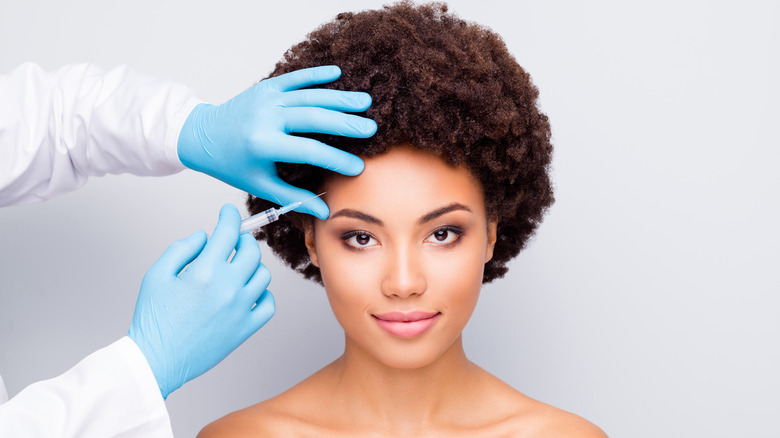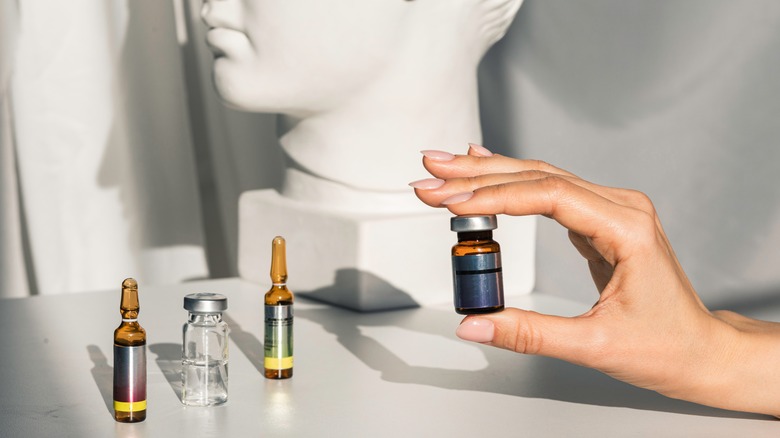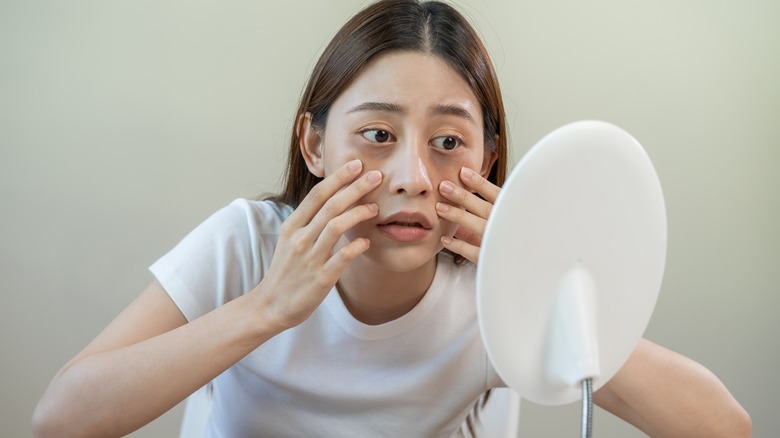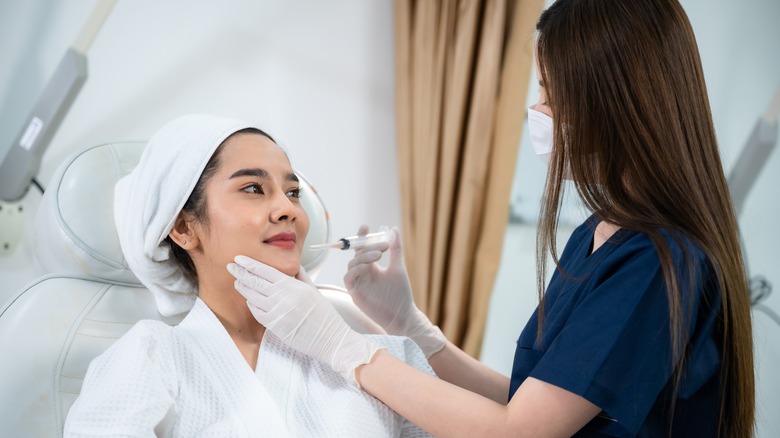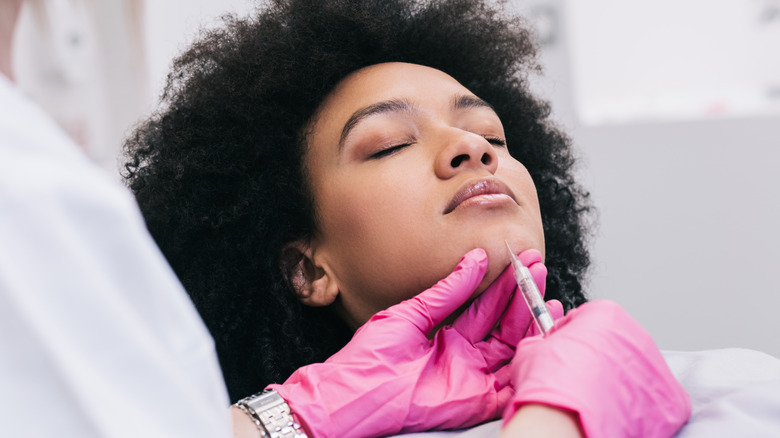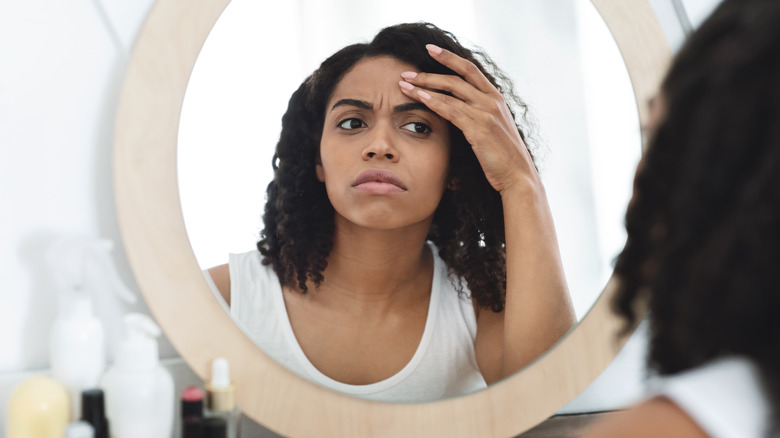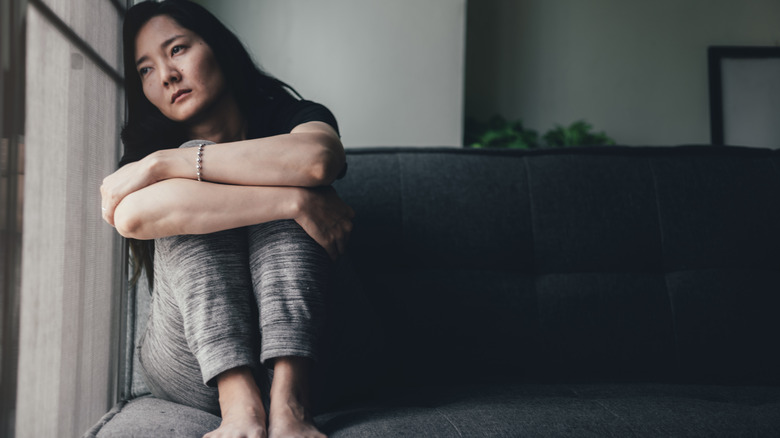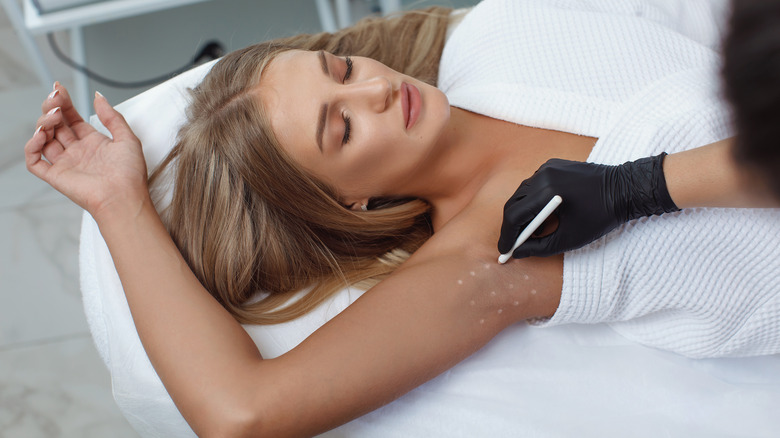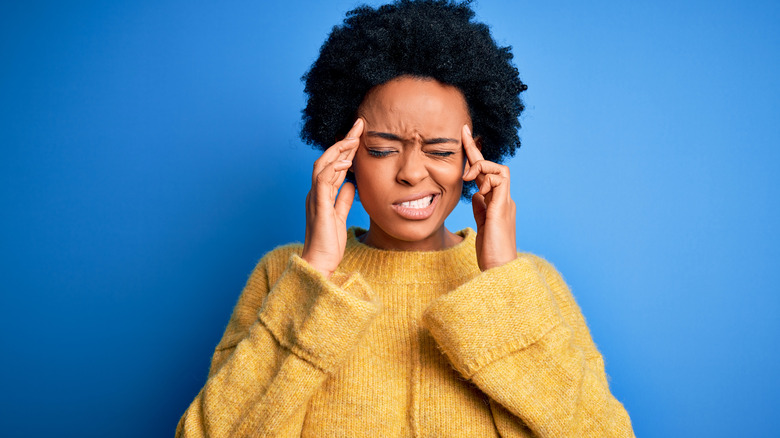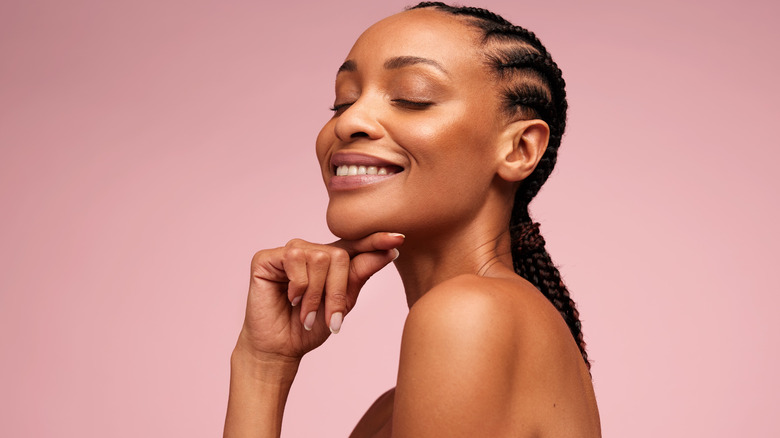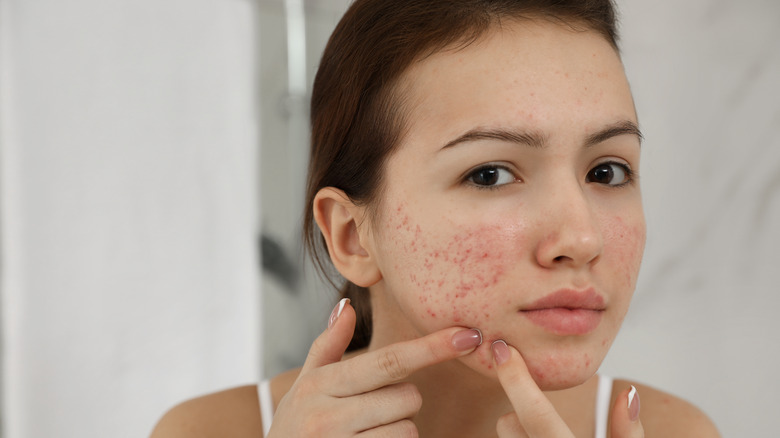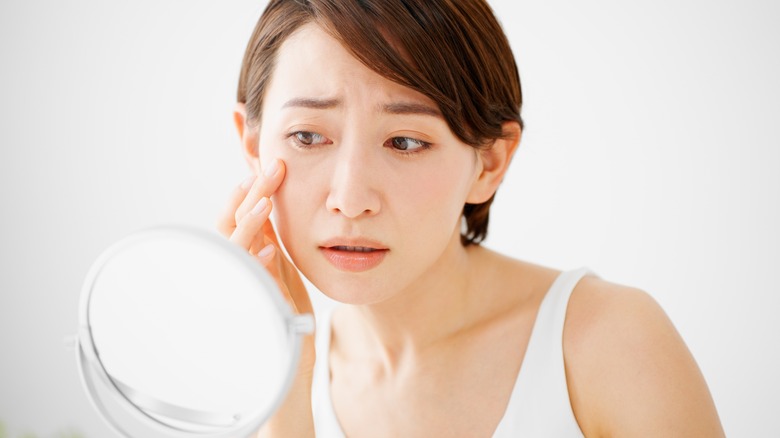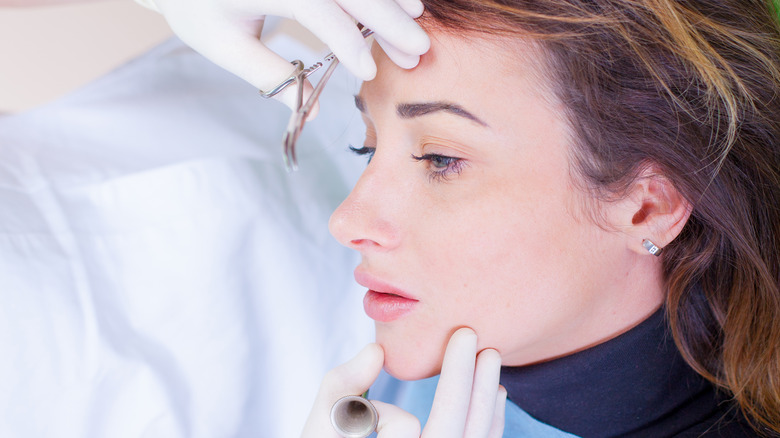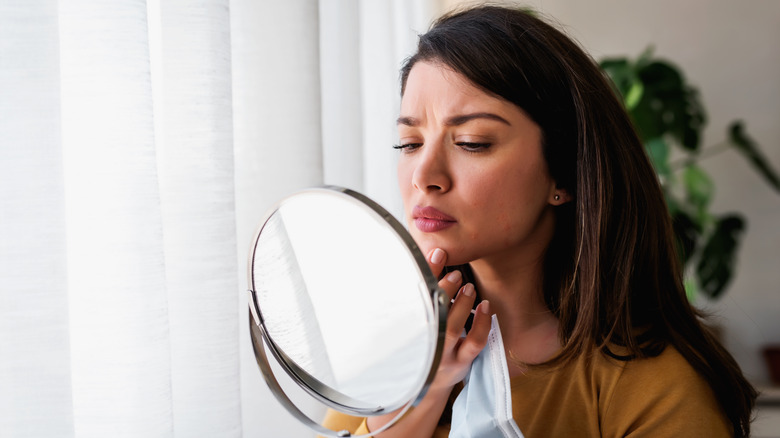Everything You Wanted To Know About Botox
Botox has been touted as somewhat of an antidote to aging. Those who want to turn back the clock and keep fine lines and wrinkles at bay often opt for this treatment, and recently it's become more popular than ever.
Speaking to HuffPost, board-certified plastic surgeon Jeremy Nikfarjam admitted that the demand for Botox at his practice has increased significantly in the last couple of years. "I would say we're up seven times our normal for Botox," he said, adding that at one point his practice was injecting Botox faster than he could replenish the stock. Indeed, board-certified dermatologist Marisa Garshick told HuffPo that the pandemic has definitely had an impact on the demand for Botox. She pointed out that since most people started working from home, they spent plenty of time looking at themselves on their computer screens during Zoom calls. This provided them with ample time to study their faces and notice imperfections.
While the main reason for Botox's popularity can be attributed to its wrinkle-smoothing abilities, it has many other medical uses as well. It can help people manage various health concerns, like excessive sweating and chronic migraines, to name just a few (via Mayo Clinic). If you've always been curious about this so-called miracle treatment, read on for everything you need to know about Botox before you try it for yourself.
Botox is a neurotoxin
If you weren't already aware of it, Botox is actually a neurotoxin. Yup, it's a very diluted version of the Clostridium botulinum bacteria's botulinum toxin, which means it's safe for your body (when used by a board-certified dermatologist or plastic surgeon), but it still has the ability to paralyze your muscles. This peculiar effect is what makes Botox so effective at fighting wrinkles and other signs of aging.
Speaking to The Healthy, board-certified plastic surgeon John Paul Tutela explained that doctors typically inject Botox around a patient's eyes, forehead, and between their eyebrows since this is where most wrinkles tend to form. The botulinum toxin then relaxes those muscles, blocking their nerve impulses, which means you won't be able to move them like you usually do when you make everyday facial expressions, board-certified dermatologist Tsippora Shainhouse told the outlet. No more bunching the muscles in your forehead together while staring at your computer screen — they simply won't get the message to contract. This gives your skin a break, preventing that frown from creating the lines associated with aging.
Botox generally doesn't pose serious risks
Unlike many other cosmetic treatments, Botox doesn't have any serious side effects. Botox treatment for fine lines and wrinkles is FDA-approved (via Botox Cosmetic), and you can expect minimal discomfort after the procedure. That said, speaking to Well+Good, board-certified dermatologic surgeon Dendy Engelman points out that making an appointment with a qualified doctor is vital.
Even though Botox is considered a fairly low-risk treatment, it would be wise to mentally prepare yourself for the possible side effects you might experience. Board-certified plastic surgeon Lesley Rabach told Well+Good that some people experience a bit of swelling and bruising post-treatment, though this is usually nothing to worry about and it doesn't happen all that often. Board-certified and reconstructive plastic surgeon Raffi Hovsepian told HuffPost that some patients feel pain where the Botox was injected, while others develop headaches or flu-like symptoms after treatment. Adverse reactions, however, are few and far between. "There have not been any serious cases of infection, pain, or any sort of reaction to this procedure so far," Hovsepian assures. Of course, that doesn't mean there isn't a possibility of infection, but Rabach says it's very unlikely to happen to a healthy individual (via Well+Good). Some patients may experience asymmetric results due to differences in muscle strength on one side of their face versus the other. If this happens, though, your doctor should be able to remedy it during a subsequent visit.
Botox doesn't last forever
All good things come to an end, and Botox is no exception. If you'd like to maintain the results, you'll have to go for regular follow-up treatments. Botox typically sticks around for three to five months. This is because our bodies naturally metabolize the botulinum toxin over time (via Well+Good). "Within a few months of injecting the Botox, the body makes new acetylcholine receptors, and the nerves are able to conduct their impulses again," board-certified dermatologist Tsippora Shainhouse told The Healthy. Reappearing wrinkles will be the first sign that Botox is starting to wear off, but the good news is that people who get injections for the first time usually find that it lasts a little longer.
Other factors can also influence Botox's longevity. Plastic surgeon Lesley Rabach told Well+Good that it's different for everyone, but if you love doing activities that boost your metabolism (i.e., exercise), it will dissipate a little quicker. The amount of toxin you were injected with also plays a role, as well as how much you use your facial muscles, surgical dermatologist Estee Williams told Healthline.
Botox should only be administered by a licensed professional
When going for Botox treatments, it's crucial that you go to a licensed medical professional. Celebrity cosmetic doctor Tijion Esho told Women's Health that you should ask the practitioner about their credentials, and if you have any doubts, find someone else. A qualified doctor would want you to come in for a consultation before the procedure and will schedule follow-up appointments so they can make sure the treatment was successful.
You might have heard of Botox parties and Botox drive-throughs, and even though these might sound fun in theory, board-certified plastic surgeon Gary Motykie told HuffPost that these are a big no-no. He says that Botox injections should only be administered in a medical setting — don't settle for anything else. Board-certified plastic and reconstructive surgeon Raffi Hovsepian adds that you should do thorough research before making a Botox appointment. "Consider a licensed professional that has knowledge of optimal treatment patterns and adverse effects," he advises.
One of the best ways to figure out whether the practitioner you're considering is any good is to check out online reviews. Former patients' level of satisfaction will give you a good idea of the doctor's capabilities. Also make sure you have an idea of what you'd like the outcome of the Botox treatment to be: Do you want to go all in, or do you prefer the result to be more natural? Knowing what you want beforehand can help you choose the right practitioner.
The procedure is quite simple and usually painless
Even though Botox involves needles, there's no need to avoid it because you're scared it'll be painful. Board-certified plastic surgeon Lesley Rabach told Well+Good that the needles used to draw blood are "massive" in comparison to those used for Botox treatments, so you can rest easy. Rabach also distracts patients from the needle by using a vibrating tool near the injection site.
Cosmetic dermatologist Peterson Pierre told HuffPost that patients typically shouldn't experience any pain during injection. You can expect to feel a tiny pinch, but that's about it. Pain at the injection site after the procedure isn't uncommon, but if you experience a lot of pain during and after the injection, Pierre advises you to find another doctor.
According to Mayo Clinic, the procedure itself is pretty straightforward. In some cases, the doctor might apply topical anesthesia to the areas where the Botox will be injected. Then they'll use a thin needle to administer the toxin. Afterward, you can go about your daily life as usual while taking care not to touch or massage the injection sites for 24 hours.
Botox can even out wrinkles, but it won't erase them
Many people have the misconception that Botox will erase every single line on their face. But while some might think it's a near-miraculous treatment, it's not magic. Speaking to Allure, board-certified plastic surgeon Michael Kane explained that, because Botox temporarily paralyzes some muscles in your face, the movement of your facial muscles diminishes, which will cause some of the lines on your face to fade. This typically includes the fine lines at the corners of your eyes, as well as frown lines and the wrinkles on your forehead. However, your face won't suddenly return to the way it looked when you were 20. Dermatologist Jill S. Waibel told The Healthy that patients shouldn't expect a miracle from Botox. Deeper wrinkles, like the ones you see in the mirror when your face is relaxed, won't fade with this treatment.
Surgical dermatologist Estee Williams told Healthline that it's unrealistic to expect Botox to erase every single line on your face: "Any line that is present at rest, whether it is an etched in frown line, or a deep wrinkle, is not going to disappear with Botox. Botox is not an iron."
Botox might be able to help manage depression
There's no doubt that many people get Botox to boost their self-confidence, but several studies now suggest that Botox might actually be a potential treatment for severe depression. A 2021 study published in Frontiers in Psychiatry found that injecting Botox between a patient's orbicularis muscle and eyebrow led to a significant decrease in depressive symptoms compared to patients who received a placebo. Researchers proceeded to subject participants to light emotional stimuli and found an obvious difference in response among participants who received Botox injections. Researchers think that because Botox puts the facial muscles in a semi-permanently relaxed state, it sends a more positive signal to the brain. The study also states that Botox injections work well to help reduce anxiety, which researchers believe is linked to the frowning muscles in the face. They refer to this theory as the facial feedback hypothesis, and they might be on to something. A 2017 study published in the Iranian Journal of Public Health went as far as to declare Botox a safe and effective treatment for severe depression.
Facial and reconstructive plastic surgeon Paul Nassif agrees with the abovementioned studies' findings. "Our facial expressions contribute to how we feel, in the way that smiling can make you feel better by doing it," he told Women's Health, adding, "Once the face is set into a natural resting state, the mechanisms of the body behave differently and the less stress response is created."
Botox can help ease excessive sweating
For some, excessive sweating, or hyperhidrosis, can be a real problem. While treatments exist for this condition, Botox can make a significant difference if traditional medication doesn't do the trick, consultant aesthetic plastic and reconstructive surgeon Hazim Sadideen told Glamour.
Director of cosmetic and clinical research in dermatology at Mount Sinai Hospital Joshua Zeichner told Allure that Botox for hyperhidrosis basically works the same way it does for wrinkles. "Similar to the way Botox works on muscles, it prevents the message from your nerves from getting to your sweat glands," he explained. "If the gland doesn't get the signal, then it doesn't produce sweat, which means there will be no wetness in that area."
Botox is administered directly to the problem areas, most commonly under the armpits. It's also not unusual for patients to get injections on other parts of their bodies, like the palms of their hands. Dermatologist Amy Wechsler told Allure that she's had patients who received injections in the soles of their feet, their scalp, forehead, and even their temples. The procedure is well worth it, Wechsler says — patients can stay sweat-free for up to six months after receiving Botox. The best part? Wechsler says that this use of Botox has been approved by the FDA, so patients can rest easy knowing it's safe.
Botox can serve as a treatment for migraines
Those who frequently deal with migraines and don't find any relief with traditional medication can consider Botox as an alternative treatment as Joshua Zeichner, director of cosmetic and clinical research in dermatology at Mount Sinai Hospital, told Allure. However, patients shouldn't see Botox as an easy fix, but rather as a last resort, Zeichner says.
According to the Mayo Clinic, Botox is considered a valid treatment for chronic migraines. Some research has been conducted to gauge Botox's efficacy when it comes to treating migraines, and a 2018 study published in the Journal of Headache and Pain declared Botox a safe and effective treatment. The study was conducted over the course of three years and found that patients tolerated the Botox treatment well while also experiencing fewer migraines on a monthly basis.
Zeichner says that it's not yet clear why Botox works to prevent migraines, but doctors think it's likely because the botulinum toxin is able to prevent pain signals from reaching the brain (via Allure). The fact that it relaxes the muscles in the face and head might also have an impact. Botox for migraines is usually injected in the patient's temples, scalp, and forehead.
Botox can be used preventatively to slow signs of aging
Speaking to Vogue, Dr. Patricia Wexler of Wexler Dermatology said that most people seeking out Botox in their 20s do so because they want to prevent the early signs of aging from showing up on their faces. But does Botox really prevent those common wrinkles like crow's feet and forehead lines? According to Wexler, yes. "Lines get deeper and deeper with age," she explains, adding, "If you start [getting Botox] early enough and it's done properly, you're not going to need [as much] in the future."
Of course, it's normal to worry that your face will look unnatural when you get Botox at a younger age. This is why going to a licensed professional is crucial. Wexler says that it's important that the facial muscles are still able to move after Botox treatment. This prevents the dreaded frozen look so many patients fear. She administers very low doses of Botox in younger patients to ensure a natural, youthful look. This also helps prevent future issues like thinning skin and weak muscles.
Botox can be used to help manage acne
Dr. Joshua Zeichner told Allure that Botox works well to keep skin's oil production in check, but don't expect it to completely eliminate acne — that would cost you your natural appearance. "To totally treat acne, you'd need to use doses of Botox so large they'd prevent you from constricting your facial muscles," Zeichner explains. You might end up with clear skin, but you won't be able to properly smile about it. Zeichner says he administers very small doses for acne-specific cases. It's enough to control oil production while also allowing patients to still move their muscles.
While Botox definitely works to help prevent acne breakouts, Zeichner suggests patients first give alternative treatments like birth control and spironolactone a try. You also shouldn't overdo it if you do opt for Botox. Zeichner says that he prefers to administer the injections in the forehead only since it's usually the most effective. Getting injections all over your face to prevent oil production is not advisable since you'll likely be left with that dreaded frozen look.
Botox can weaken your muscles over time
Though Botox is both an effective and safe procedure, there's one long-term side effect you might want to keep in mind before going for regular treatments. Botox primarily affects your muscles, and as dermatologist Patricia Wexler explained to Vogue, our facial muscles become weaker as we age. Too much Botox can actually increase the severity of this weakening, leading to unwanted side effects like skin that looks thin and loose. This happens when the muscles start to lose their tone and shape, Wexler says. In addition to your skin starting to look saggy, your other facial muscles might start to compensate for the weaker ones, leading to the formation of wrinkles on other areas of the face. You'll then need additional Botox to take care of those lines, and it kind of turns into a vicious cycle. However, Wexler says that this is preventable. Usually, muscle weakness results because doctors administer doses that are too high. She added that this is one of the reasons why it's important to find a trusted and experienced practitioner. She also encourages patients to ask questions about the dosage, and to remember that less is more.
It's normal for your face to feel strange after getting Botox
When you get Botox for the first time, the way your face feels afterward might come as a bit of a shock. "Botox will affect the way your facial muscles move, and it can feel funny when you can't move your face to make a particular expression," dermatologist Tsippora Shainhouse told The Healthy. This is completely normal, and some people explain the sensation as feeling like someone stuck duct tape to your forehead. Shainhouse says you might even notice that your face feels incredibly tight after the treatment. This is simply your body trying to adjust to the botulinum toxin.
If, however, you end up with a droopy eyelid or lowered brows, it might mean that the toxin moved away from the original injection site. This is a risk associated with Botox treatment and is less than ideal. Shainhouse says that following post-treatment instructions is vital in preventing this from happening.
Botox results aren't instant
Even though you'll be well aware that your face had been pricked with needles, you actually won't see the fruit of the doctor's labor until a few days after your Botox treatment. Speaking to Allure, board-certified dermatologist Howard Sobel said that the time it takes to see Botox results differ from person to person, but you can expect to start seeing a change four or five days after treatment. According to HuffPost, small changes might be visible within 48 hours, but the toxin needs some time to complete its work. Within seven to ten days, it will have successfully worked its way through your facial muscles. Board-certified dermatologist Tsippora Shainhouse told The Healthy that patients can typically expect to see the final results within two weeks' time. So if your face looks pretty much the same right after getting Botox, there's nothing to worry about. Simply follow the aftercare instructions and be patient.

